Keyword: Eutrophication
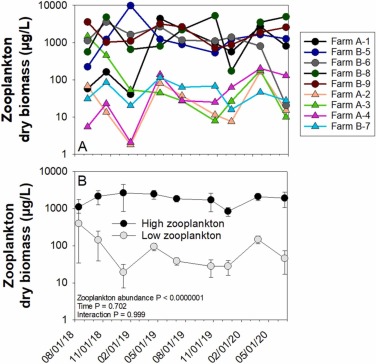
Belfiore, A., R. P. Buley, E. G. Fernandez-Figueroa, M. Gladfelter, and A. E. Wilson. 2021. Zooplankton as an alternative method for controlling phytoplankton in catfish pond aquaculture. Aquaculture Reports 21:100897.
Abstract
In pond aquaculture, production of toxins and off-flavor compounds by cyanobacteria can negatively affect fish health and production. Studies have explored chemical or physical methods for controlling algal blooms in aquaculture ponds, which although effective, may be short-lived and can negatively impact non-target organisms, including aquaculture species. Food web manipulations have a long history in lake and fisheries management to improve water quality, but have been rarely considered in aquaculture. This study examined zooplankton and phytoplankton communities, cyanobacterial toxins, and nutrients in nine catfish aquaculture farm-ponds in west Alabama, USA. The goal of this project was to track phytoplankton and zooplankton abundances with respect to each other, with and without efforts to reduce zooplanktivorous fish in some of the ponds. During this project, farm managers reduced zooplanktivorous fish abundance in select ponds to create a large-scale field experiment that addressed the role of zooplankton control of phytoplankton in hypereutrophic catfish aquaculture ponds when zooplanktivorous fish were or were not excluded. There was a strong negative effect of zooplankton on phytoplankton, including cyanobacteria, despite high nutrient concentrations. Although high zooplankton ponds sustained elevated zooplankton biomass during much of this study, including when pond temperatures exceeded 30 °C, the effect of zooplankton on phytoplankton was most pronounced during the non-growing season (November–April). In addition, total ammonia nitrogen was significantly higher in high zooplankton ponds, which could lead to ammonia toxicity in fish at elevated temperature and pH. Our findings suggest that zooplankton biomanipulation may be an efficient method to control algal blooms in farm-pond catfish aquaculture.
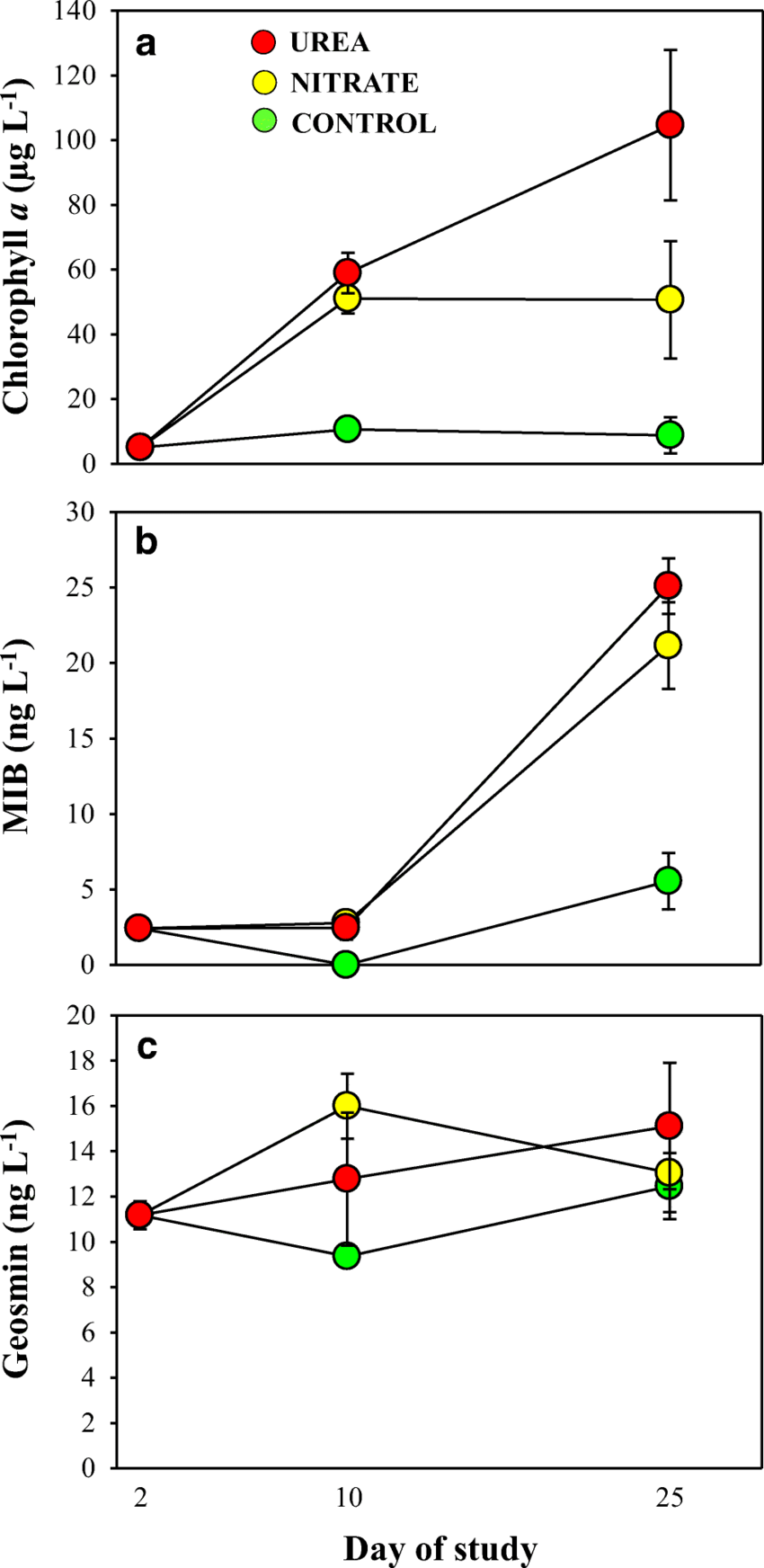
Chislock, M. F., B. K. Olsen, J.J. Choi, A. Abebe, T. L. Bleier, and A. E. Wilson. 2021. Contrasting patterns of 2-methylisoborneol (MIB) vs. geosmin across depth in a drinking water reservoir are mediated by cyanobacteria and actinobacteria. Environmental Science and Pollution Research 28:32005-32014.
Abstract
Taste and odor episodes caused by off-flavor secondary metabolites, such as 2-methylisoborneol (MIB) and geosmin, pose one of the greatest challenges for drinking water utilities around the world. The prevalence of these compounds is predicted to increase in the future as a function of nutrient enrichment and elevated temperatures of surface drinking water sources. We conducted a manipulative field experiment in a drinking water reservoir to elucidate patterns for two taste and odor compounds, MIB and geosmin, as well as two taxa known to produce these compounds, phytoplankton (more specifically, cyanobacteria) and actinobacteria, across different depths in response to nutrient enrichment with two common dissolved nitrogen forms, organic urea or inorganic nitrate. In general, we found that MIB levels increased by greater than 250% with nutrient enrichment mediated by increased phytoplankton biomass. However, the effect of the fertilization treatments on MIB decreased with depth with a 35% reduction at 7 m versus 1.5 m. In contrast, geosmin levels reached a maximum at the lowest measured depth (7 m), were unaffected by the fertilization treatments, and followed a similar pattern to the abundance of actinobacteria. Thus, our data suggest that the positive response of phytoplankton (e.g., cyanobacteria, such as Oscillatoria species) to the fertilization treatments is likely responsible for increased MIB, while geosmin concentrations may be a function of actinobacteria-mediated decomposition in the hypolimnion in our study system.
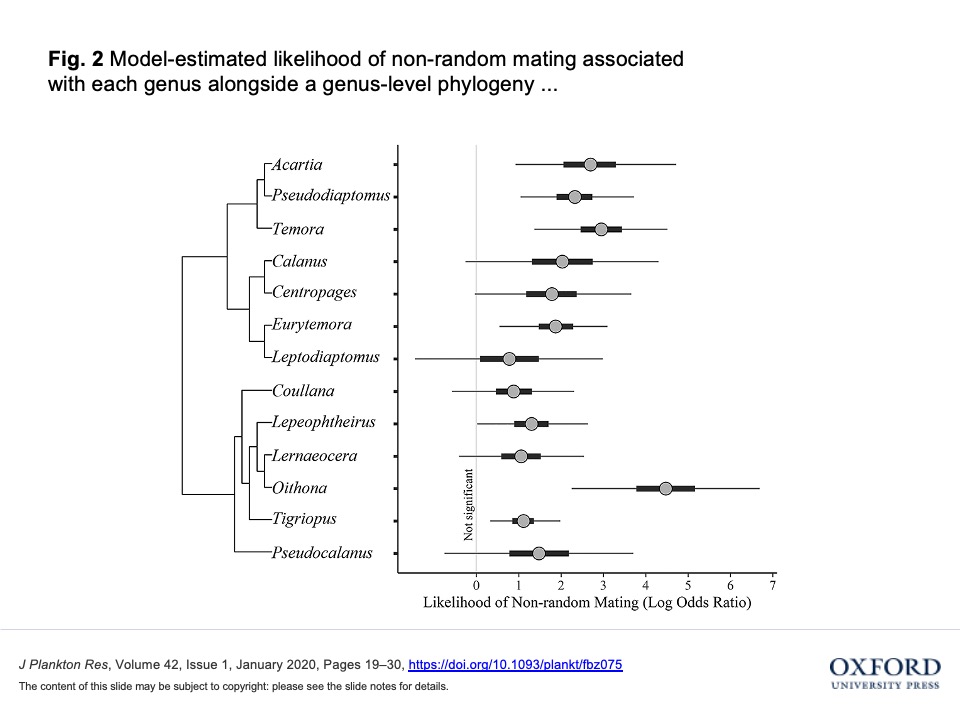
Powers, M. J., A. E. Wilson, K. B. Heine, and G. E. Hill. 2020. The relative importance of various mating criteria in copepods. Journal of Plankton Research 42(1):19-30.
Abstract
To produce viable offspring, organisms may assess mates via criteria that include traits, such as sex, species, age, reproductive status, population identity and individual quality. Copepods are small, ubiquitous crustaceans that live in freshwater and marine systems around the world whose patterns of mate choice have been long studied in numerous species. Herein, we synthesized decades of experiments describing sexual selection in copepods to assess the importance of mating criteria. We used formal, meta-analytical techniques and mixed modeling to quantify the likelihood of non-random mating associated with mating criteria. In our synthesis of the scientific literature, we found that copepods use several criteria when assessing mates and that these criteria are associated with different likelihood estimates. We report the strongest likelihood of non-random mating when copepods assess the reproductive status of females or when copepods select between conspecific vs. heterospecific mates. We found weak likelihood of non-random mating in studies that provide mates from different populations or that manipulate operational sex ratio. Studies that directly test assessment of individual quality are sparse in copepods when compared to equivalent studies in vertebrates, and we encourage future researchers to explore whether copepods use individual characteristics as key mating criteria.
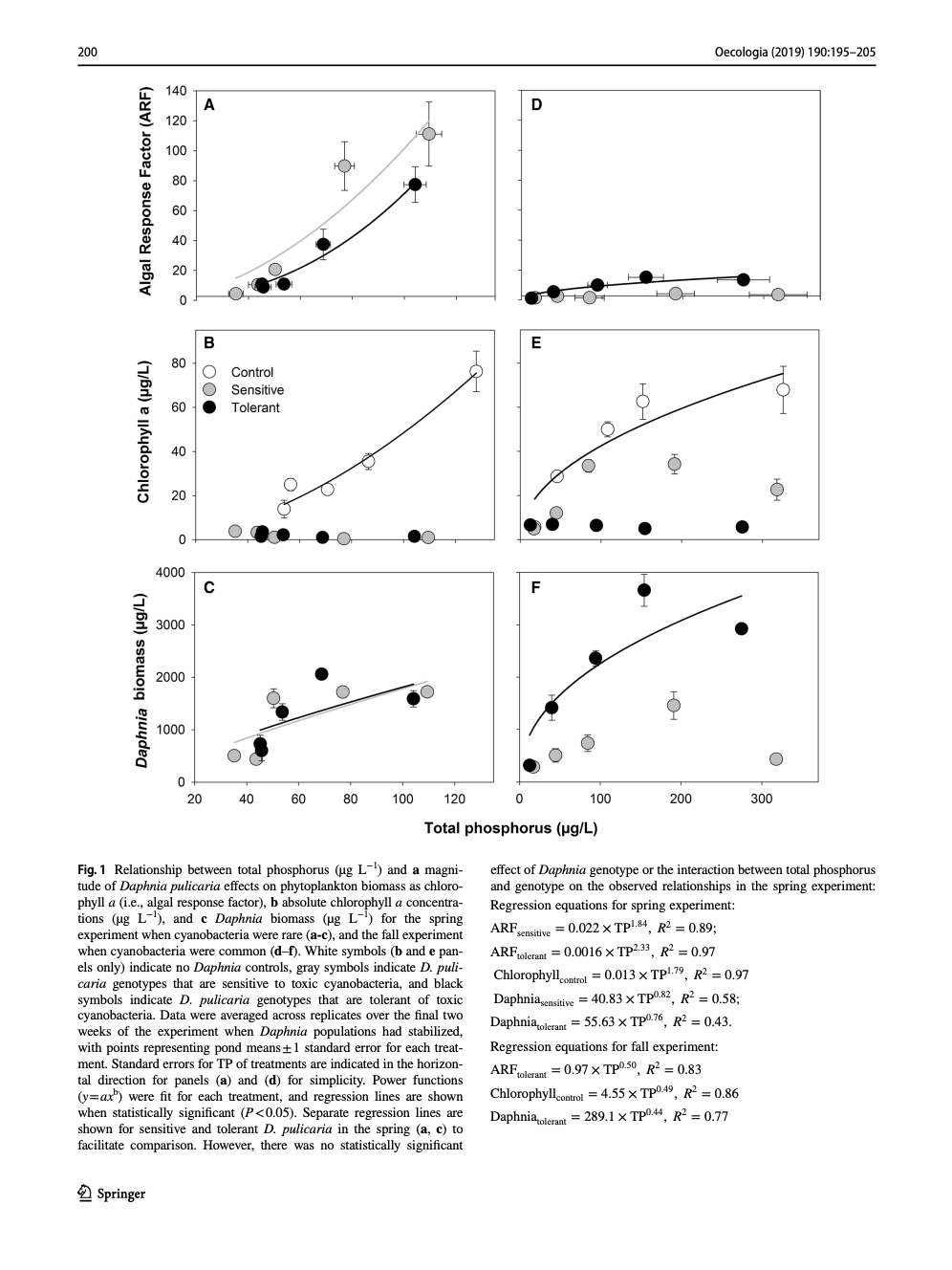
Chislock, M. F., O. Sarnelle, L. M. Jernigan, V. R. Anderson, A. Abebe, and A. E. Wilson. 2019. Consumer adaptation mediates top-down regulation across a productivity gradient. Oecologia 190:195-205.
Abstract
Humans have artificially enhanced the productivity of terrestrial and aquatic ecosystems on a global scale by increasing nutrient loading. While the consequences of eutrophication are well known (e.g., harmful algal blooms and toxic cyanobacteria), most studies tend to examine short-term responses relative to the time scales of heritable adaptive change. Thus, the potential role of adaptation by organisms in stabilizing the response of ecological systems to such perturbations is largely unknown. We tested the hypothesis that adaptation by a generalist consumer (Daphnia pulicaria) to toxic prey (cyanobacteria) mediates the response of plankton communities to nutrient enrichment. Overall, the strength of Daphnia’s top–down effect on primary producer biomass increased with productivity. However, these effects were contingent on prey traits (e.g., rare vs. common toxic cyanobacteria) and consumer genotype (i.e., tolerant vs sensitive to toxic cyanobacteria). Tolerant Daphnia strongly suppressed toxic cyanobacteria in nutrient-rich ponds, but sensitive Daphnia did not. In contrast, both tolerant and sensitive Daphnia genotypes had comparable effects on producer biomass when toxic cyanobacteria were absent. Our results demonstrate that organismal adaptation is critical for understanding and predicting ecosystem-level consequences of anthropogenic environmental perturbations.
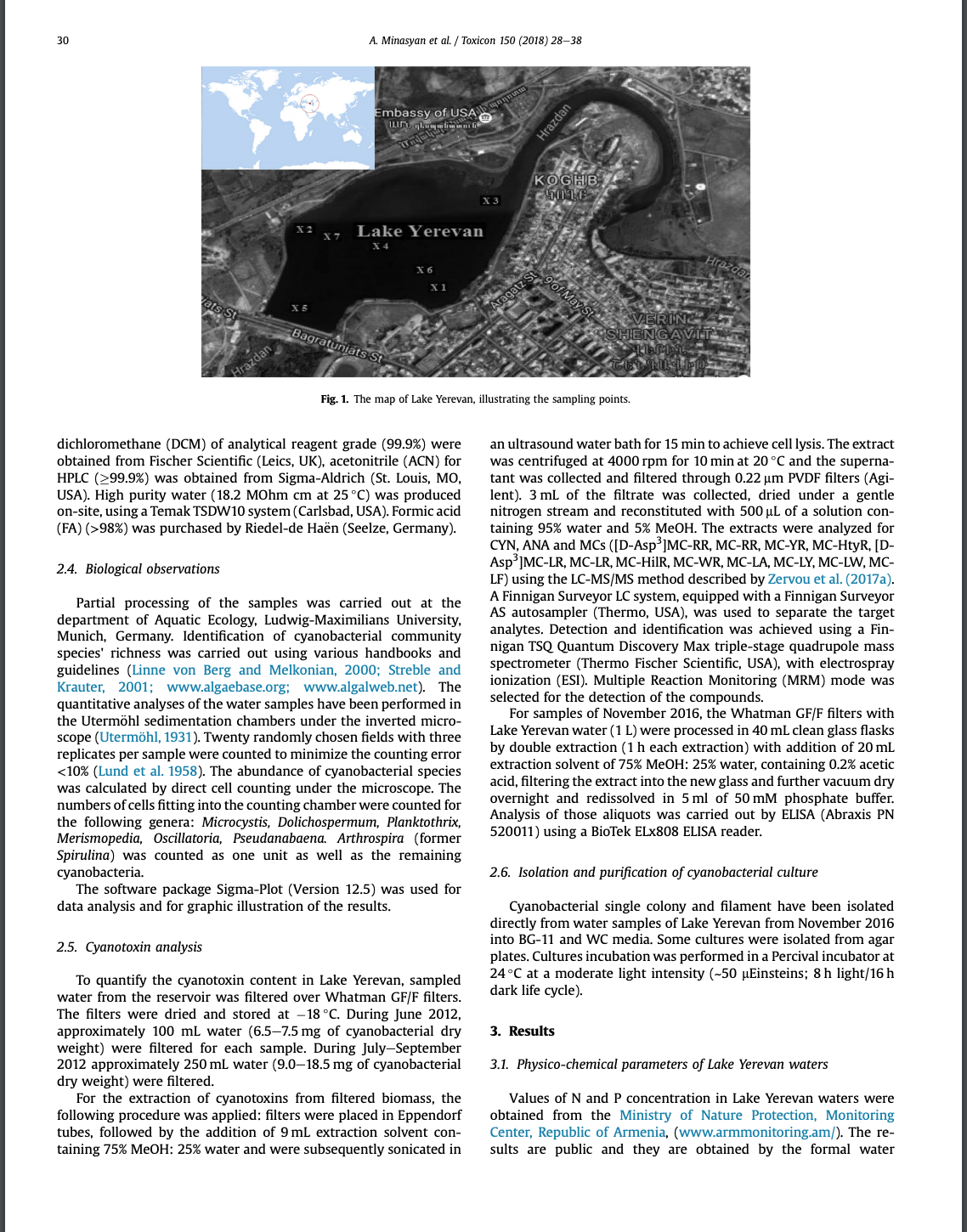
Minasyan, A., C. Christophoridis, A. E. Wilson, S.-K. Zervou, T. Kaloudis, and A. Hiskia. 2018. Diversity of cyanobacteria and the presence of cyanotoxins in the epilimnion of Lake Yerevan (Armenia). Toxicon 150:28-38.
Abstract
This paper presents the first report of cyanobacteria and cyanotoxins from the South Caucasus region, in particular from Lake Yerevan (Armenia). Microcystis, Dolichospermum and Planktothrix were the key genera identified during the growing season. A trend of a remarkable increase in cyanobacterial densities was observed from 2012 to 2013 exhibiting bloom formation in June (by Nostoc linckia) with the highest values in June and August 2013, reaching up to 695.9*103 cells mL−1. Seasonal dependence of cyanobacterial density on temperature, and temperature as a driver for cyanobacterial cells growth and development were suggested. Biogenic nutrients were identified as co-drivers determining species richness and dominance, as well as the distribution of phytoplankton in different parts of the reservoir. Cyanotoxin concentrations in the filtered biomass were reported during July 2012 for both stations of the reservoir (left and right bank). Microcystin-RR (MC-RR) was the most abundant and the most frequently observed cyanotoxin. Lower MC-LR concentrations were identified in all samples from both stations, with the highest values observed at the right bank in July 2012. [D-Asp3]MC-RR, MC-YR, MC-HtyR, [D-Asp3]MC-LR, MC-HilR, MC-WR, MC-LY and MC-LW were also identified in trace levels. Anatoxin-a (ANA) was reported in the samples from both stations during August 2012. Cylindrospermopsin (CYN) was present in trace concentrations in samples from both stations during July and in the sample from the left bank during September.
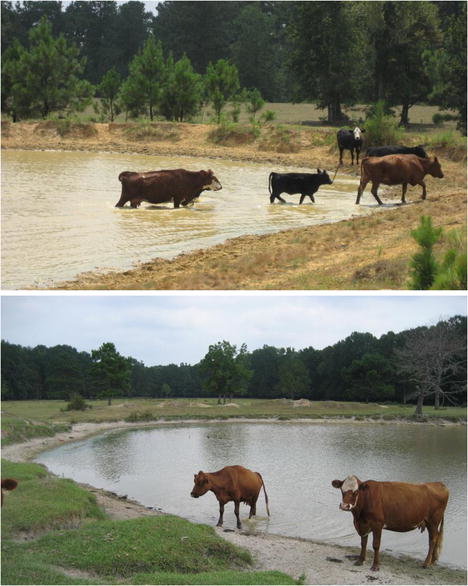
Wilson, A. E., M. F. Chislock, Z. Yang, M. U.G. Barros, and J. F. Roberts. 2018. Pond bank access as an approach for managing toxic cyanobacteria in beef cattle pasture drinking water ponds. Environmental Monitoring and Assessment 190:247.
Abstract
Forty-one livestock drinking water ponds in Alabama beef cattle pastures during were surveyed during the late summer to generally understand water quality patterns in these important water resources. Since livestock drinking water ponds are prone to excess nutrients that typically lead to eutrophication, which can promote blooms of toxigenic phytoplankton such as cyanobacteria, we also assessed the threat of exposure to the hepatotoxin, microcystin. Eighty percent of the ponds studied contained measurable microcystin, while three of these ponds had concentrations above human drinking water thresholds set by the US Environmental Protection Agency (i.e., 0.3 μg/L). Water quality patterns in the livestock drinking water ponds contrasted sharply with patterns typically observed for temperate freshwater lakes and reservoirs. Namely, we found several non-linear relationships between phytoplankton abundance (measured as chlorophyll) and nutrients or total suspended solids. Livestock had direct access to all the study ponds. Consequently, the proportion of inorganic suspended solids (e.g., sediment) increased with higher concentrations of total suspended solids, which underlies these patterns. Unimodal relationships were also observed between microcystin and phytoplankton abundance or nutrients. Euglenoids were abundant in the four ponds with chlorophyll concentrations > 250 μg/L (and dominated three of these ponds), which could explain why ponds with high chlorophyll concentrations would have low microcystin concentrations. Based on observations made during sampling events and available water quality data, livestock-mediated bioturbation is causing elevated total suspended solids that lead to reduced phytoplankton abundance and microcystin despite high concentrations of nutrients, such as phosphorus and nitrogen. Thus, livestock could be used to manage algal blooms, including toxic secondary metabolites, in their drinking water ponds by allowing them to walk in the ponds to increase turbidity.
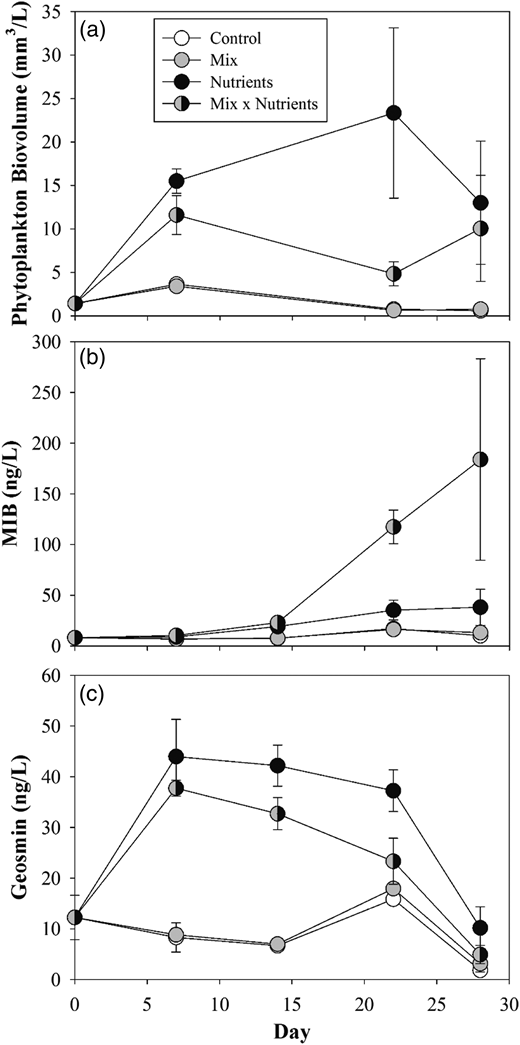
Olsen, B. K., M. F. Chislock, A. Rebelein, and A. E. Wilson. 2017. Nutrient enrichment and vertical mixing mediate 2-methylisoborneol and geosmin concentrations in a drinking water reservoir. Water Science and Technology: Water Supply 17(2):500-507.
Abstract
Few ecosystem-level studies have experimentally determined the physicochemical and biological factors that mediate concentrations of off-flavor compounds in drinking water reservoirs. Consequently, the watershed-scale mechanisms determining production of these compounds are still poorly understood. In a recent study, the addition of both nitrogen and phosphorus significantly increased 2-methylisoborneol (MIB). Not surprisingly, MIB was correlated with cyanobacterial abundance (a well-known producer of off-flavor compounds); however, MIB was most strongly correlated with diatom abundance. To empirically test for differences in the production of two important off-flavor compounds, specifically MIB and geosmin, by either cyanobacteria or diatoms, we conducted a fully factorial experiment that manipulated two factors that typically promote cyanobacteria (nitrogen and phosphorus fertilization) or diatoms (vertical mixing of the water column). As predicted, fertilization promoted cyanobacteria, and vertical mixing favored diatoms. Interestingly, the production of geosmin was rapid and consistent with an increase in cyanobacteria while MIB production increased later in the experiment when cyanobacterial biovolume tended to decline and diatom biovolume increased. Based on our current and previous studies, MIB and geosmin production is associated with cyanobacteria, but the direct or indirect influence of diatoms on production should not be ignored.
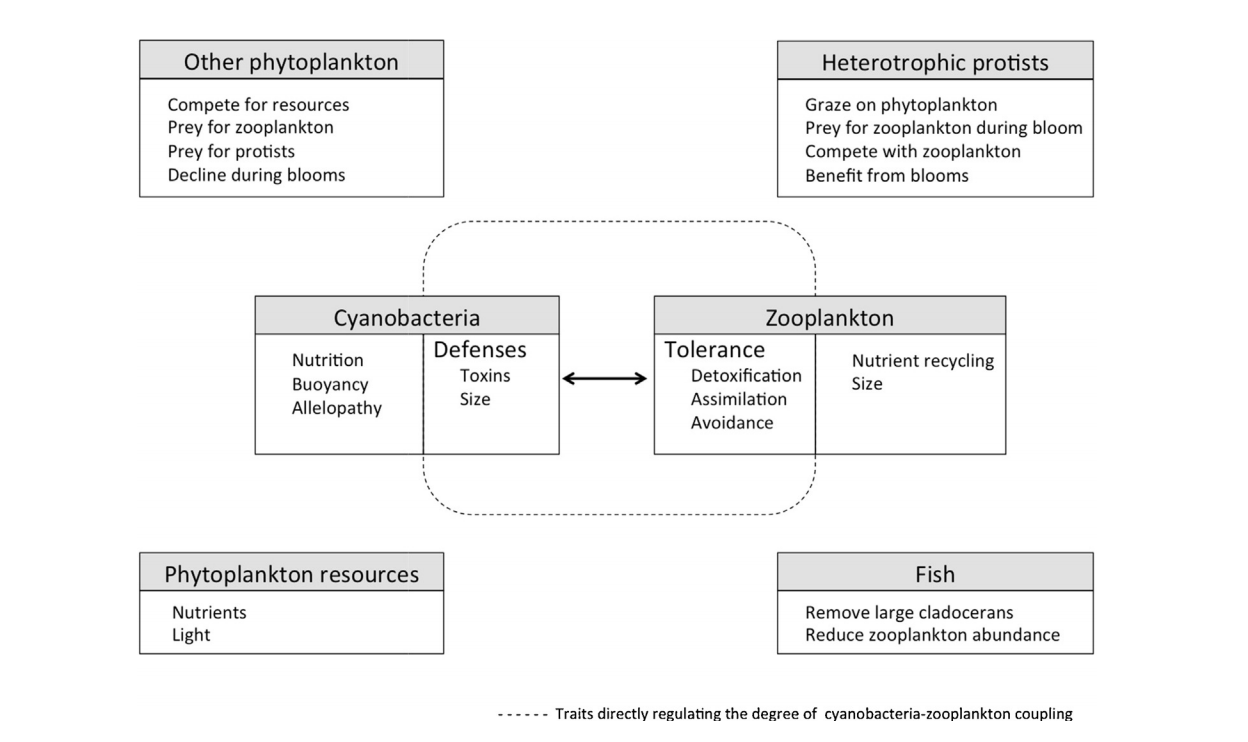
Ger, K. A., P. Urrutia-Cordero, P. C. Frost, L.-A. Hansson, O. Sarnelle, A. E. Wilson, and M. Lurling. 2016. The interaction between cyanobacteria and zooplankton in a more eutrophic world. Harmful Algae 54:128-144. (Clarivate Analytics Web of Science Highly Cited Paper)
Abstract
As blooms of cyanobacteria expand and intensify in freshwater systems globally, there is increasing interest in their ecological effects. In addition to being public health hazards, cyanobacteria have long been considered a poor quality food for key zooplankton grazers that link phytoplankton to higher trophic levels. While past laboratory studies have found negative effects of nutritional constraints and defensive traits (i.e., toxicity and colonial or filamentous morphology) on the fitness of large generalist grazers (i.e., Daphnia), cyanobacterial blooms often co-exist with high biomass of small-bodied zooplankton in nature. Indeed, recent studies highlight the remarkable diversity and flexibility in zooplankton responses to cyanobacterial prey. Reviewed here are results from a wide range of laboratory and field experiments examining the interaction of cyanobacteria and a diverse zooplankton taxa including cladocerans, copepods, and heterotrophic protists from temperate to tropical freshwater systems. This synthesis shows that longer exposure to cyanobacteria can shift zooplankton communities toward better-adapted species, select for more tolerant genotypes within a species, and induce traits within the lifetime of individual zooplankton. In turn, the function of bloom-dominated plankton ecosystems, the coupling between primary producers and grazers, the stability of blooms, and the potential to use top down biomanipulation for controlling cyanobacteria depend largely on the species, abundance, and traits of interacting cyanobacteria and zooplankton. Understanding the drivers and consequences of zooplankton traits, such as physiological detoxification and selective vs. generalist grazing behavior, are therefore of major importance for future studies. Ultimately, co-evolutionary dynamics between cyanobacteria and their grazers may emerge as a critical regulator of blooms.
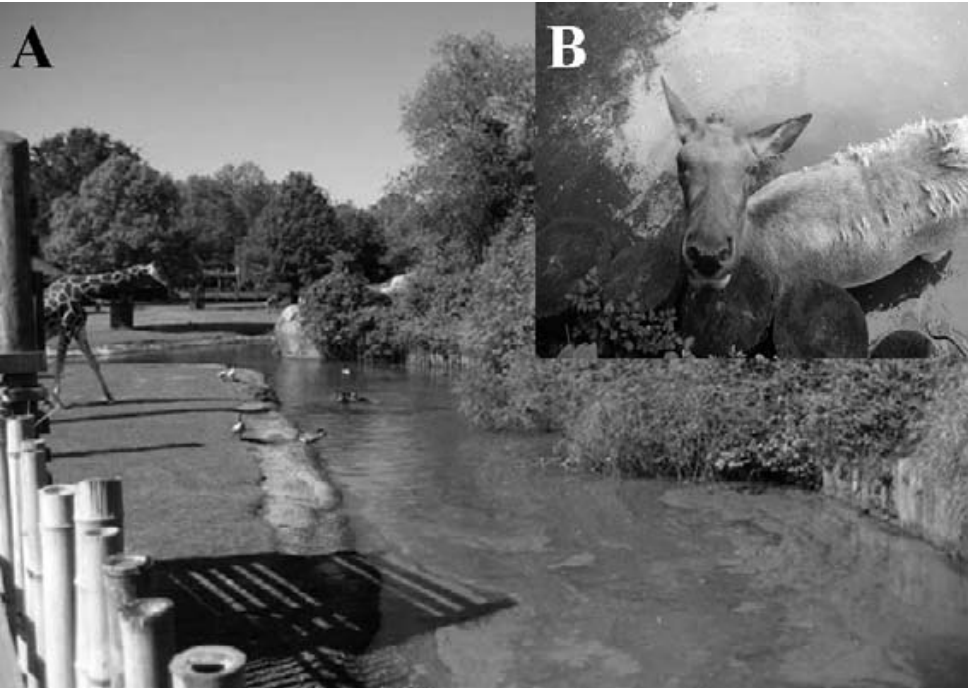
Doster, E., M. F. Chislock, J. F. Roberts, J. J. Kottwitz, and A. E. Wilson. 2014. Recognition of an important water quality issue at zoos: prevalence and potential threat of toxic cyanobacteria. Journal of Zoo and Wildlife Medicine 45(1):165-168.
Abstract
Zoo animals may be particularly vulnerable to water sources contaminated with cyanobacterial toxins given their nonvoluntary close association with this resource. However, the prevalence and potential threat of toxic cyanobacteria in this setting are unknown. Several otherwise unexplained yellow-bellied slider (Trachemys scripta scripta) deaths were documented in a zoo moat with recurring blooms of toxic Microcystis aeruginosa. Furthermore, an extremely high and potentially lethal concentration of the hepatotoxin microcystin (166 ng/g) was found in the liver of a necropsied turtle that died in this moat. A subsequent monthly survey of water quality revealed detectable concentrations of microcystin in all moats (0.0001 to 7.5 μg/L), with moats higher than 1 μg/L being significantly higher than the threshold for safe drinking water recommended by the World Health Organization. These results demonstrate that cyanobacterial blooms are an important water quality issue in zoos, and future research is necessary to identify potential associations among water quality, zoo animal health, and moat management strategies.
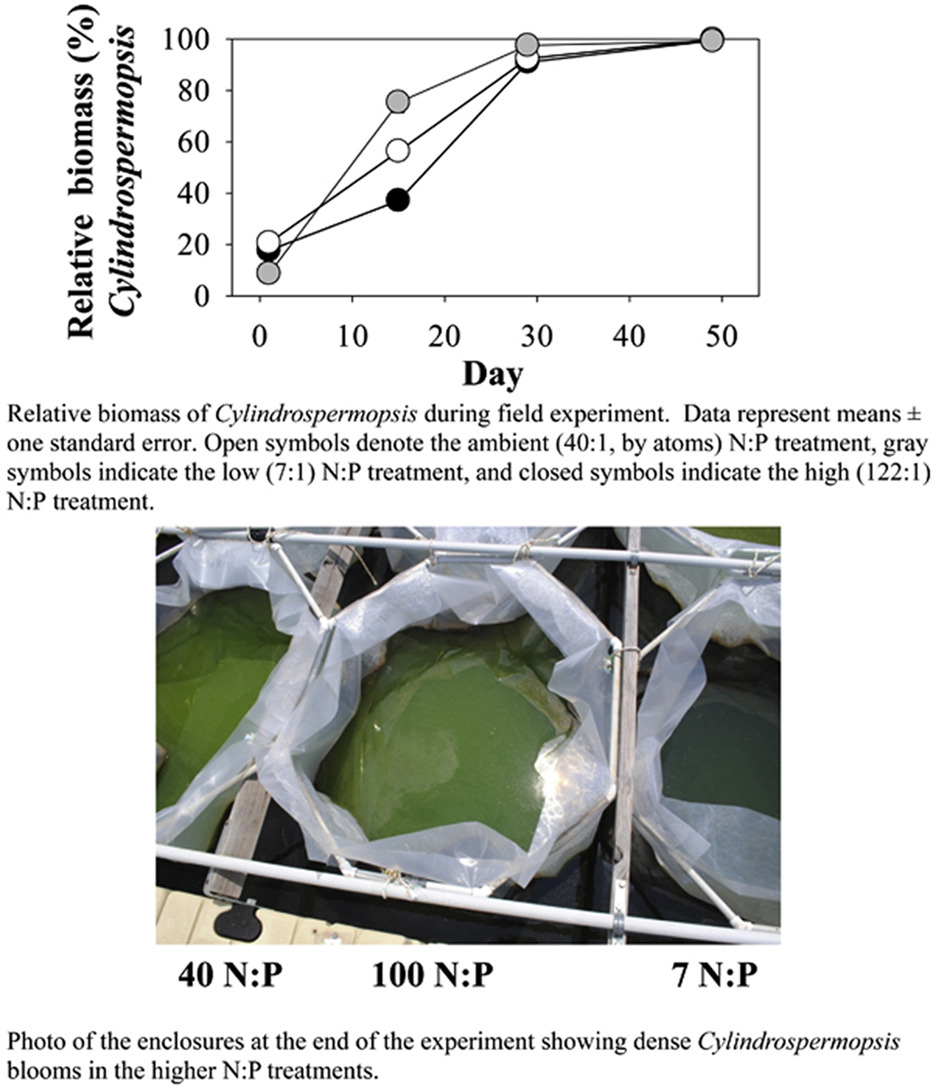
Chislock, M. F., K. L. Sharp, and A. E. Wilson. 2014. Cylindrospermopsis raciborskii dominates under very low and high nitrogen-to-phosphorus ratios. Water Research 49:207-214.
Abstract
In freshwater ecosystems, a variety of factors mediate phytoplankton community structure, including herbivore community structure, light availability, temperature, mixing, and absolute and relative nutrient concentrations (total nitrogen (TN), total phosphorus (TP)). Ecological stoichiometry examines how the nutrient content of organisms and their environment may mediate population-, community-, and ecosystem-level processes. The manipulation of N:P ratios is a widely regarded tool for managing phytoplankton species composition given that nitrogen-fixing cyanobacteria should dominate algal communities under relatively low N:P (<64:1, by atoms) given their ability to convert dissolved dinitrogen gas into organic nitrogen. However, due to the physiological expense of nitrogen fixation, diazotrophs should be outcompeted by non-nitrogen fixing phytoplankton under higher N:P when other environmental factors are similar. We tested this hypothesis in a field experiment using 2500-L limnocorrals installed in a eutrophic lake (ambient N:P ∼40:1 (by atoms); TN ∼1360 μg L−1; TP ∼75 μg L−1). At the start of the experiment, we randomly assigned limnocorrals among the ambient (40:1) and low (7:1) or high (122:1) N:P treatments (n = 4 replicates/treatment), which were established by adding P or N at the start of the experiment, respectively. The phytoplankton community in the enclosures at the start of the experiment was diverse (i.e., 18 phytoplankton genera) and dominated by chlorophytes (including Coelastrum and Scenedesmus (30% and 13% of total biomass, respectively)) and cyanobacteria (including Anabaena and Cylindrospermopsis (23% and 17% of total biomass, respectively)). In contrast to predictions based on ecological stoichiometry, the phytoplankton community in all N:P treatments increased in abundance and was almost entirely composed of the nitrogen-fixing cyanobacterium, Cylindrospermopsis raciborskii, by the conclusion of the study. Moreover, concentrations of the cyanobacterial neurotoxin, saxitoxin, were enhanced under the two highest N:P conditions. The ability of C. raciborskii to dominate phytoplankton communities under such extreme N:P shows that short-term management of nutrient stoichiometry through fertilization is not likely to be effective for controlling blooms of this noxious cyanobacterium and may help to explain the rapid expansion of this invasive species to temperate latitudes.